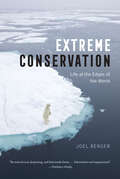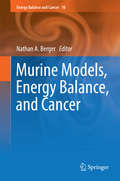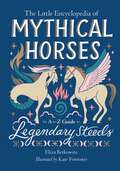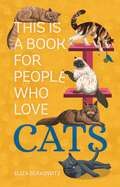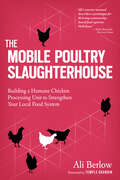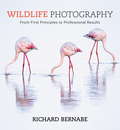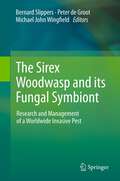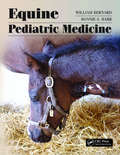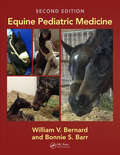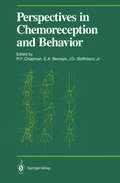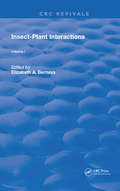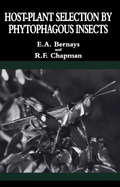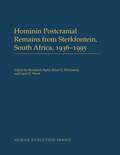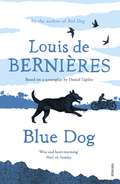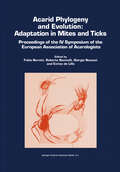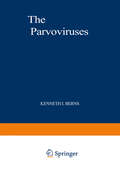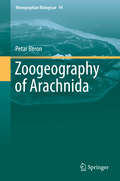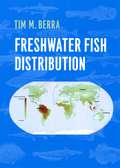- Table View
- List View
Extreme Conservation: Life at the Edges of the World
by Joel Berger"Extraordinary. . . . Berger is a hero of biology who deserves the highest honors that science can bestow."—Tim Flannery, New York Review of Books On the Tibetan Plateau, there are wild yaks with blood cells thinner than those of horses’ by half, enabling the endangered yaks to survive at 40 below zero and in the lowest oxygen levels of the mountaintops. But climate change is causing the snow patterns here to shift, and with the snows, the entire ecosystem. Food and water are vaporizing in this warming environment, and these beasts of ice and thin air are extraordinarily ill-equipped for the change. A journey into some of the most forbidding landscapes on earth, Joel Berger’s Extreme Conservation is an eye-opening, steely look at what it takes for animals like these to live at the edges of existence. But more than this, it is a revealing exploration of how climate change and people are affecting even the most far-flung niches of our planet. Berger’s quest to understand these creatures’ struggles takes him to some of the most remote corners and peaks of the globe: across Arctic tundra and the frozen Chukchi Sea to study muskoxen, into the Bhutanese Himalayas to follow the rarely sighted takin, and through the Gobi Desert to track the proboscis-swinging saiga. Known as much for his rigorous, scientific methods of developing solutions to conservation challenges as for his penchant for donning moose and polar bear costumes to understand the mindsets of his subjects more closely, Berger is a guide par excellence. He is a scientist and storyteller who has made his life working with desert nomads, in zones that typically require Sherpas and oxygen canisters. Recounting animals as charismatic as their landscapes are extreme, Berger’s unforgettable tale carries us with humor and expertise to the ends of the earth and back. But as his adventures show, the more adapted a species has become to its particular ecological niche, the more devastating climate change can be. Life at the extremes is more challenging than ever, and the need for action, for solutions, has never been greater.
Extreme Conservation: Life at the Edges of the World
by Joel Berger"Extraordinary. . . . Berger is a hero of biology who deserves the highest honors that science can bestow."—Tim Flannery, New York Review of Books On the Tibetan Plateau, there are wild yaks with blood cells thinner than those of horses’ by half, enabling the endangered yaks to survive at 40 below zero and in the lowest oxygen levels of the mountaintops. But climate change is causing the snow patterns here to shift, and with the snows, the entire ecosystem. Food and water are vaporizing in this warming environment, and these beasts of ice and thin air are extraordinarily ill-equipped for the change. A journey into some of the most forbidding landscapes on earth, Joel Berger’s Extreme Conservation is an eye-opening, steely look at what it takes for animals like these to live at the edges of existence. But more than this, it is a revealing exploration of how climate change and people are affecting even the most far-flung niches of our planet. Berger’s quest to understand these creatures’ struggles takes him to some of the most remote corners and peaks of the globe: across Arctic tundra and the frozen Chukchi Sea to study muskoxen, into the Bhutanese Himalayas to follow the rarely sighted takin, and through the Gobi Desert to track the proboscis-swinging saiga. Known as much for his rigorous, scientific methods of developing solutions to conservation challenges as for his penchant for donning moose and polar bear costumes to understand the mindsets of his subjects more closely, Berger is a guide par excellence. He is a scientist and storyteller who has made his life working with desert nomads, in zones that typically require Sherpas and oxygen canisters. Recounting animals as charismatic as their landscapes are extreme, Berger’s unforgettable tale carries us with humor and expertise to the ends of the earth and back. But as his adventures show, the more adapted a species has become to its particular ecological niche, the more devastating climate change can be. Life at the extremes is more challenging than ever, and the need for action, for solutions, has never been greater.
Murine Models, Energy Balance, and Cancer (Energy Balance and Cancer #10)
by Nathan A. BergerThis volume provides a transdisciplinary and translational review of many of the leading murine models used to study the mechanisms, mediators and biomarkers linking energy balance to cancer. It provides a review of murine models that should be of interest to basic, clinical and applied research investigators as well as nutrition scientists and students that work in cancer prevention, cancer control and treatment. The worldwide obesity pandemic has been extensively studied by epidemiologic and observational studies and even, in some cases, by randomized controlled trials. However, the development and control of obesity, its comorbidities and its impact on cancer usually occurs over such long periods that it is difficult, if not impossible to conduct randomized controlled trials in humans to investigate environmental contributions to obesity, energy balance and their impact on cancer. In contrast, model organisms, especially mice and rats, provide valuable assets for performing these studies under rigorously controlled conditions and in sufficient numbers to provide statistically significant results. In this volume, many of the leading and new murine models used to study the mechanisms and mediators linking cancer with obesity, sleep, exercise, their modification by environment and how they may continue to be used to further elucidate these relations as well as to explore preclinical aspects of prevention and/or therapeutic intervention are considered. This volume provides an important compilation and analysis of major experimental systems and principles for further preclinical research with translational impact on energy balance and cancer.
Veterinary Laser Surgery: A Practical Guide
by Noel A. Berger Peter H. EegSurgical and therapeutic use of lasers began in human medicine in the early 1960s. Technology and equipment advanced rapidly. Over the last ten years veterinarians have been exploring the many potential advantages that various lasers provide their patients. Because laser light energy can be applied directly to target tissue or administered to distant lesions at a remote site through fiberoptic components, laser surgery has become an invaluable and growing veterinary surgical resource. Unlike many medical technologies, the size, reliability, and portability of lasers have improved so rapidly that they are now both economically and practically feasible for the general and specialty veterinarian. Routine laser use in veterinary medicine stands poised to gain large-scale general acceptance for everyday routine and specialty procedures. Written by experts in the field, Veterinary Laser Surgery: A Practical Guide strives to help general and specialty veterinary practitioners understand, implement and expand the use of laser energy in safe and rational ways for both surgical and therapeutic procedures to further improvement the veterinarians ability to enhance the patient’s quality of life. PRACTICAL PICTORIAL GUIDE / ATLAS feature that includes 31 case studies of the most common laser surgery procedures. Broad spectrum of specific laser information, including chapters covering basic laser physics through specific laser surgery techniques and pain management. Special sections on CO2 and Diode laser wavelengths. Provides veterinarians with skills and techniques to improve the comfort and quality of patients’ lives through appropriate laser use. User-friendly format makes referencing easy. A practical reference for specialty and general veterinarians.
Conservation Behavior: Applying Behavioral Ecology To Wildlife Conservation And Management (PDF) (Conservation Biology Ser. #21)
by Oded Berger-Tal David SaltzConservation behavior assists the investigation of species endangerment associated with managing animals impacted by anthropogenic activities. It employs a theoretical framework that examines the mechanisms, development, function, and phylogeny of behavior variation in order to develop practical tools for preventing biodiversity loss and extinction. Developed from a symposium held at the International Congress on Conservation Biology in 2011, this is the first book to offer an in-depth, logical framework that identifies three vital areas for understanding conservation behavior: anthropogenic threats to wildlife, conservation and management protocols, and indicators of anthropogenic threats. Bridging the gap between behavioral ecology and conservation biology, this volume ascertains key links between the fields, explores the theoretical foundations of these linkages, and connects them to practical wildlife management tools and concise applicable advice. Adopting a clear and structured approach throughout, this book is a vital resource for graduate students, academic researchers, and wildlife managers.
The Little Encyclopedia of Mythical Horses: An A-to-Z Guide to Legendary Steeds (The Little Encyclopedias of Mythological Creatures)
by Eliza BerkowitzFrom Arthurian legend to tales of ancient China, horses have traversed the world alongside humans for centuries, and their heroic adventures are gathered here in this one-of-a-kind little encyclopedia . . . Beloved for their grace, strength, and untamed beauty, horses have always loomed large in our imaginations, featuring in mythologies across cultures and throughout history. This little encyclopedia rounds up more than 50 mythical horses from around the world, including: Bai Long Ma, part dragon and part horse, of the Chinese classic Journey to the West Balius and Xanthus, Achilles's horses who fought in the Trojan War Pegasus, a winged stallion and child of the Greek god Poseidon Sleipnir, a war horse belonging to great Norse god Odin And so many more! With detailed illustrations throughout, this book pays tribute to some of our most formidable equine friends.
This Is a Book for People Who Love Cats (This Is a Book for People Who Love)
by Eliza BerkowitzFull of feline facts, lessons translating cat behavior, and illustrated breed profiles, This Is a Book for People Who Love Cats is a joyful celebration of all nine lives of cat friends! For cat lovers of all ages, this beautifully illustrated guide offers an informative look at the world and lives of cats. Cat enthusiast Eliza Berkowitz highlights why we love cats so much, how cats became domesticated, and just what they're doing and saying with their odd behavior. Fascinating profiles of cat breeds, from Maine Coons and Calicos to Bengals and Egyptian Maus, are accompanied by charming illustrations that will make you fall in love with cats all over again... and again. Comprehensively researched and shared in an accessible, appealing format, This Is a Book for People Who Love Cats is a purr-fect addition to every cat lover's library.
Thrombin: Structure and Function
by Lawrence J. BerlinerResearch on thrombin structure and function has progressed significantly over the past three decades. We are continually discovering new functions f()r this enzyme in biology. Yet, until quite recently, a full, detailed, three dimensional picture of its structure was difficult to attain. We believe that this text represents a turning point and, more appropriately, a new start ing point for thrombin studies. Our goal for this text is to present a thorough and rounded-out coverage of thrombin chemistry and biochem istry in order to provide the biochemist and physiologist with an excellent desk reference on almost any thrombin-related problem. This volume is organized into three general thrombin topic areas: Structure, Biochemistry, and Physiology. In Part 1, Structure, we open with the complete three-dimensional x-ray structures of two inhibited human thrombin complexes, one of which is the thrombin-hirudin com plex. These complexes are also addressed in the chapter on structural studies in solution, which include NMR, ESR, and fluorescence. Part 2, Biochemistry, includes chapters on synthetic thrombin inhibitors, protein inhibitors (e.g., antithrombin III, hirudin), and thrombin interactions with factor XIII. Part 3, Physiology, covers such topics as chemotactic activities, interactions with cell surfaces, and the vascular endothelium.
The Mobile Poultry Slaughterhouse: Building a Humane Chicken-Processing Unit to Strengthen Your Local Food System
by Ali BerlowAli Berlow offers a step-by-step guide to building a mobile poultry slaughterhouse that can serve communities and small farmers.
Wildlife Photography: An Expert Guide
by Richard BernabeThere is nothing quite so satisfying as capturing a stunning wildlife photograph; a good one will reflect practice, patience, careful equipment choice and dedication. Those challenges are perhaps why so many enthusiast photographers aspire to perfect their images in this area; to get their work recognised by the photographic community as well as record their experiences.This book reveals more world-class images with every turn. More than that, though, it takes a practical approach. It comprehensively introduces natural-history and wildlife photography techniques alongside truly useful tips about what gear you'll need (and what you can avoid) in your pursuit of perfection. It is illustrated by the author's professional work; his clients include National Geographic & Time amongst others.
The Sirex Woodwasp and its Fungal Symbiont: Research and Management of a Worldwide Invasive Pest
by Bernard Slippers, Peter de Groot and Michael John WingfieldThe Sirex woodwasp, Sirex noctilio, is the most important invasive alien insect pest of Pinus plantations in the Southern Hemisphere. It now also threatens pines in North America. This book brings together the worldwide knowledge of researchers from Universities and Government institutions, as well as forest industry practitioners that have worked on the pest. Importantly, it is the first comprehensive treatment of the subject since S. noctilio was discovered outside its native range around 1900. The book covers all aspects of the biology and management of S. noctilio, including aspects of the insects’ taxonomy, general life history, host-plant relationships, population dynamics, chemical ecology and symbiosis with the fungus Amylostereum areolatum. The book also contains a comprehensive synthesis of the history and current status of the pest and worldwide efforts to control it, including biological control, silviculture and quarantine.
Equine Pediatric Medicine
by William Bernard Bonnie BarrThis book is a systematic and concise guide to equine pediatric medicine covering etiology, pathophysiology, clinical presentation, differential diagnosis, diagnosis, and management. The book is superbly illustrated throughout with photographs, line diagrams and radiographs. This book is of particular value to equine practitioners as a ready refere
Equine Pediatric Medicine (Manson Ser.)
by William Bernard Bonnie BarrThis book is a systematic and concise guide to equine pediatric medicine covering etiology, pathophysiology, clinical presentation, differential diagnosis, diagnosis, and management. The book is superbly illustrated throughout with photographs, line diagrams and radiographs. This book is of particular value to equine practitioners as a ready refere
Equine Pediatric Medicine
by William V. Bernard Bonnie S. BarrKey features New chapter on nutrition Includes new section of case studies Completely revised and updated chapters throughout This systematic yet concise guide to equine pediatric medicine covers etiology, pathophysiology, clinical presentation, differential diagnosis, diagnosis, and management. Beginning with a thorough explanation of the physical examination, the chapters then take the reader through the different disorders associated with each body system, including liver, cardiovascular, respiratory, opthalmologic, endocrine, and muscoskeletal diseases. A brand new chapter on nutrition has been added to this fully revised text. The book is superbly illustrated throughout with photographs, diagrams, radiographs and tables, while a new section of in-depth case studies brings the information to life and is ideal for students. Equine practitioners will value this as a ready reference, while veterinary students and technicians can use it as a complete guide to equine pediatric disease.
Equine Pediatric Medicine (Manson Ser.)
by William V. Bernard Bonnie S. BarrKey features New chapter on nutrition Includes new section of case studies Completely revised and updated chapters throughout This systematic yet concise guide to equine pediatric medicine covers etiology, pathophysiology, clinical presentation, differential diagnosis, diagnosis, and management. Beginning with a thorough explanation of the physical examination, the chapters then take the reader through the different disorders associated with each body system, including liver, cardiovascular, respiratory, opthalmologic, endocrine, and muscoskeletal diseases. A brand new chapter on nutrition has been added to this fully revised text. The book is superbly illustrated throughout with photographs, diagrams, radiographs and tables, while a new section of in-depth case studies brings the information to life and is ideal for students. Equine practitioners will value this as a ready reference, while veterinary students and technicians can use it as a complete guide to equine pediatric disease.
Perspectives in Chemoreception and Behavior: Papers Presented at a Symposium Held at the University of Massachusetts, Amherst in May 1985 (Proceedings in Life Sciences)
by E. A. BernaysIn the study of the physiological basis of animal behavior Vince Dethier has been a pioneer, a guiding star. Although his own work has centered on the blowfly and the caterpillar, his interests and influence have spread far beyond the insects. The breadth of this impact is indicated by the contributions from colleagues and former students in this volume. These papers were originally presented at a meeting to honor Vince's 70th birthday held at the University of Massachusetts, Amherst, in May 1985. It was attended by friends and col leagues of all ages from many parts of the world. However, the picture presented by these papers is not the whole story. What it does not show is the extent of Vince's interest and influence beyond the rigorous, though friendly, atmosphere of the research laboratory. His idyllic summers in Maine have produced studies on the natural history of feeding by insects culminating in The Tent Makers, with more to come. In these studies we see his real love and, dare we say, understanding of the insect. Vince Dethier is not concerned simply with reaching the established scientist. In To Know a Fly he reaches out to those just beginning, perhaps even to those who will never begin, and provides insight both to the experimentalist's approach and to the fun of research. His sense of fun and his elegant, fluent writing have given us, too, his tongue-in-cheek fictional writings for children of all ages.
Insect-Plant Interactions (Routledge Revivals #1)
by Elizabeth A. BernaysFirst Published in 1989, this book explores the relationship between plants and insects and the ways in which they interact with each other. Carefully compiled and filled with a vast repertoire of notes, diagrams, and references this book serves as a useful reference for students of oncology, and other practitioners in their respective fields.
Insect-Plant Interactions (Routledge Revivals #1)
by Elizabeth A. BernaysFirst Published in 1989, this book explores the relationship between plants and insects and the ways in which they interact with each other. Carefully compiled and filled with a vast repertoire of notes, diagrams, and references this book serves as a useful reference for students of oncology, and other practitioners in their respective fields.
Host-Plant Selection by Phytophagous Insects (Contemporary Topics in Entomology #2)
by Elizabeth A. Bernays Reginald F. ChapmanFor more than 20 years insect/plant relations have been a focus for studies in ecology and evolution. The importance of insects as crop pests, and the great potential of insects for the biological control of weeds, have provided further impetus for work in this area. All this attention has resulted in books on various aspects of the topic, and reviews and research papers are abundant. So why write another book? It seems to us that, in the midst of all this activity, behavior has been neglected. We do not mean to suggest that there have not been admirable papers on behavior. The fact that we can write this book attests to that. But we feel that, too often, behavior is relegated to a back seat. In comparison to the major ecological and evolutionary questions, it may seem trivial. Yet the whole process of host-plant selection and host-plant specificity amongst insects depends on behavior, and selection for behavioral differences must be a prime factor in the evolution of host-plant specificity. In writing this book, we hope to draw attention to this central role of behavior and, hopefully, encourage a few students to attack some of the very difficult questions that remain unanswered.
Hominin Postcranial Remains from Sterkfontein, South Africa, 1936-1995 (Human Evolution Series)
by Bernhard Zipfel, Brian G. Richmond, and Carol V. WardThe 1924 African discovery of an early hominin child's skull, referred to as Australopithecus africanus by Raymond Dart, was a major event in the history of paleoanthropology. This provided the first evidence of early hominins in Africa and overturned conventional ideas about human evolution. Subsequent discoveries of A. africanus fossils, notably from cave deposits at Sterkfontein, yielded the first evidence that early hominins were habitual bipeds. Fifty years after this, the discovered wealth of fossil evidence in eastern Africa of the slightly older and craniodentally more primitive taxon, A. afarensis, catalyzed debates about the origin and evolution of human gait and the phylogentic relationships among early hominins. This formed the main basis of our understanding of early hominin bipedality and paleobiology. Little attention has been paid to the variation among species in postcranial anatomy and locomotion, although intriguing hints are beginning to appear in the literature. Did multiple varieties of bipedality evolve? Did australopith species differ in positional or manipulative abilities, body proportions, or patterns of sexual dimorphism? These are critical questions for understanding the evolution of australopiths and hominin locomotion. In this book, Bernhard Zipfel, Brian Richmond, Carol Ward, and the most knowledgeable scholars in their respective fields provide groundbreaking accounts for each postcranial fossil and expert examinations into the background of each fossil. The chapters include standardized high-quality photographs and anatomical descriptions to allow readers to read the book entirely or learn by comparing features across chapters. Hominin Postcranial Remains from Sterkfontein, South Africa, 1936-1995 is an evolutionary history of South African hominins, and it offers readers an orientation and introduction to the field. This is an important reference book for professional paleontologists, paleobiologists, anthropologists, geologists, students, and historians interested in human evolution.
Blue Dog
by Louis De Bernieres'The kind of book that changes readers for the better' GuardianWhen a family tragedy means Mick is sent to the outback to live with his Granpa, it looks as if he has a lonely life ahead of him. The cattle station is a tough place for a child, where nature is brutal and the men must work hard in the heat and dust. However, after a cyclone hits, things change for Mick. Exploring the floodwaters, he finds a lost puppy covered in mud and half-drowned. Mick and his dog immediately become inseparable as they take on the adventures offered by their unusual home, and the business of growing up, together. In this charming prequel to the much-loved Red Dog, Louis de Bernières tells the moving story of a young boy and his Granpa, and the charismatic and entertaining dog who so many readers hold close to their hearts.
Acarid Phylogeny and Evolution: Proceedings of the IV Symposium of the European Association of Acarologists
by Fabio Bernini Roberto Nannelli Giorgio Nuzzaci Enrico De LilloThe words pronounced by Serge Kreiter during the meeting come to mind. They could record exactly the situation of Acarology in Europe and in the World: "I think that in many European countries there are very few full time acarologists. It is very rare to have new positions available . . . . And public money, from the European Community but also from national countries, is very hard to get when you want to work on mites . . . . Could two acarological associations in Europe (Eur. A. Ac. and S. I. A. L. F) work together or, better, get married?" So, the fourth symposium of the European Acarologists has not only been the occasion to have an idea on which direction the research is addressed today, but also it pointed out the difficulties of our "scientific hranch". On the basis of the presentations and invited papers we had evidences of a "new" Acarology based on modern techniques and methods of investigations but also the importance, often sheltered even if of relevant value, of the "old" Acarology made on the alpha taxonomy and basic studies. So, a "new" Acarology needs the "old" one. In this context, the hope to put together the European acarologists has been coming up. This fact, of political meaning, can surely improve the acarological movement and the discussion on this point showed clearly the importance of several other activities and efforts in this direction. We hope that the meeting in Siena will represent a significative stone for the progress of Acarology.
Zoogeography of Arachnida (Monographiae Biologicae #94)
by Petar BeronThis volume merges all geographical and paleogeographical data on all groups of the arachnofauna. The book features topics such as the ecological factors, climate and other barriers that influence the distribution of arachnida. It also elaborates on the characteristics of the distribution such as arachnida at high altitude (e.g. Himalaya), in caves, in polar regions and highlights differences between the arachnofauna of e.g. Mediterranean regions vs Central Europe, West African vs Indomalayan and more. Furthermore, amongst other topics the volume also includes chapters on the systems of arachnida, fossil orders, dispersal and dispersion, endemics and relicts, regional arachnogeography, cave and high altitude arachnida.
Freshwater Fish Distribution (American Politics And Political Economy Ser.)
by Tim M. BerraWith more than 29,000 species, fishes are the most diverse group of vertebrates on the planet. Of that number, more than 12,000 species are found in freshwater ecosystems, which occupy less than 1 percent of the Earth’s surface and contain only 2.4 percent of plant and animal species. But, on a hectare-for-hectare basis, freshwater ecosystems are richer in species than more extensive terrestrial and marine habitats. Examination of the distribution patterns of fishes in these fresh waters reveals much about continental movements and climate changes and has long been critical to biogeographical studies and research in ecology and evolution. Tim Berra’s seminal resource, Freshwater Fish Distribution,maps the 169 fish families that swim in fresh water around the world. Each family account includes the class, subclass, and order; a pronunciation guide to the family name; life cycle information; and interesting natural history facts. Each account is illustrated, many with historical nineteenth-century woodcuts. Now available in paperback, this heavily cited work in ichthyology and biogeography will serve as a reference for students, a research support for professors, and a helpful guide to tropical fish hobbyists and anglers.
